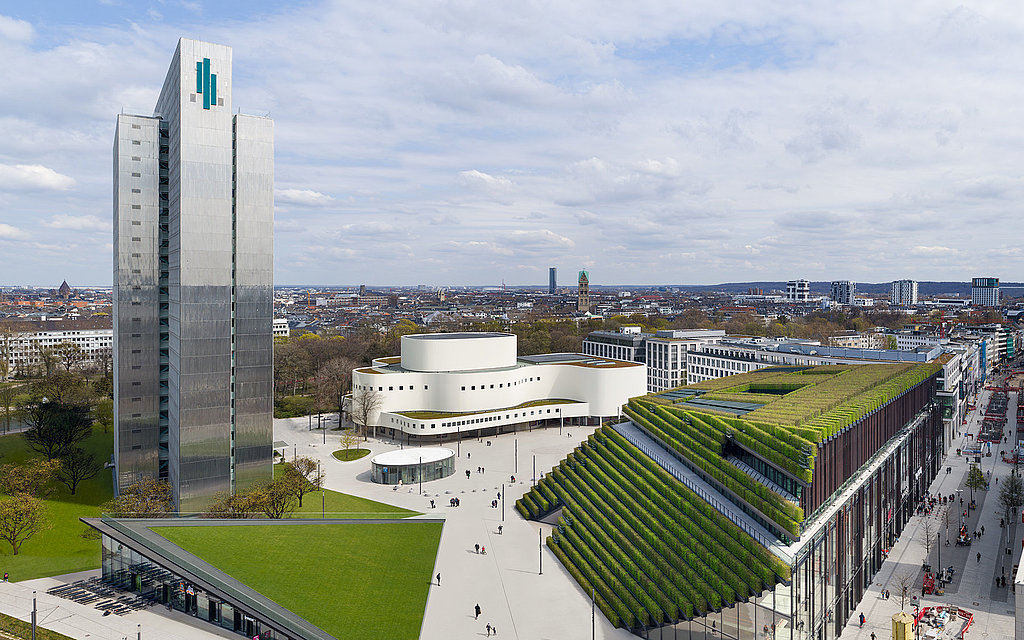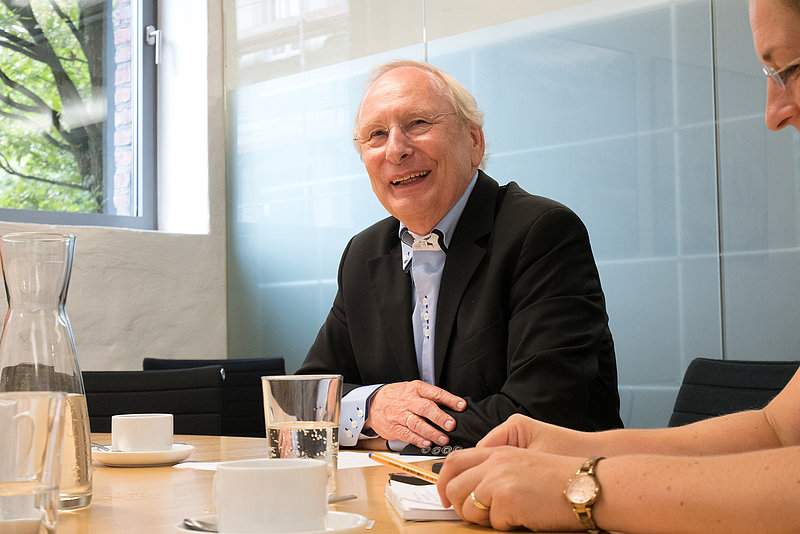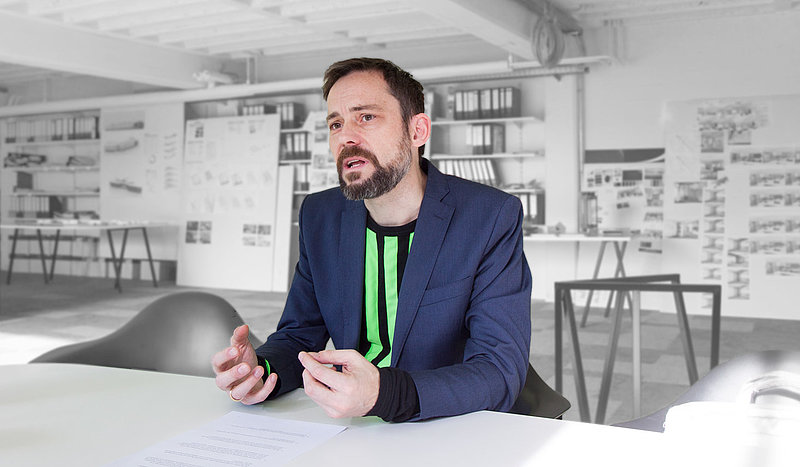
30.03.2022
"Let us entertain you." (based on the band Queen)
From the requirements of the project in Dusseldorf to the finished SHADOW LIGHTS. The interview on the creation of this extraordinary luminaire with Prof. Clemens Tropp (Tropp Lighting Design GmbH) and Prof. Lutz Büsing (solonero).
In conversation with Lutz Büsing (left) and Clemens Tropp (right).
Reference Project "Gustaf-Gründgens-Platz | Kö-Bogen II, Dusseldorf"

Prof. Tropp and Prof. Büsing, I would first like to ask you both a basic question: what does light in the urban realm mean to you?
Prof. Büsing: Liveable urban spaces have an atmospheric quality that invites people to linger and interact. This includes locations for recreation, public places for playing, celebrating and learning, areas set aside for sport and exercise and venues for cultural performances. It is precisely the public parks, squares and intersections that shape the spaces that bring us together in a way that is good for us, without these locations necessarily being linked to the consumption of goods and services.
To improve the quality of the time we spend together in urban spaces, also in the evening hours, we need contemporary lighting concepts that provide such places with comfortable, functional and stimulating light. For me, it is the “Dark Sky” and “Smart City” concepts that dictate the minimum standards for any new planning project.
Let’s move on to the “Kö-Bogen II” commercial building project. What was the task and objective in this case?
Prof. Tropp: We had already been commissioned with the lighting design of the theatre, the underground car park and the public spaces of Kö-Bogen II when we were also entrusted with Gustaf-Gründgens-Platz. We were thus already well within the world of theatre, making it clear that Gustaf-Gründgens-Platz should be atmospherically integrated into this special environment. It needed to become a vibrant and attractive place – like a stage. Simply “brightening up” the surroundings evenly would have been the wrong thing to do.
In addition to the theatre, the square also needed to become an attractive place in the evening – so it came down to staging the space. This also meant that the square’s atmosphere would be capable of change. Just like a theatre stage, a variety of different scenes needed to be possible here. This was a necessity that also corresponded to the ideas of the architects.
The luminaires themselves were to recede into the background. They needed to be well hidden so that you would not see a large number of “luminous glass cylinders” on the square in the evening.
As lighting designers, we knew exactly what the column had to accomplish technically, but we also knew that a professional approach was needed in terms of design.
Prof. Büsing: It quickly became clear to us that it would be difficult to find a suitable column that would meet the requirements and correspond to the vision of this project. What’s more, we recognised almost instantly that this would be a genuinely new development, one that can only succeed through a tightly interwoven tapestry of architecture, lighting design and product design. The square is framed by two architectural icons of postwar modernism, the Dreischeibenhaus office building and the Düsseldorfer Schauspielhaus, as well as the recently completed Kö-Bogen II, which includes Europe’s largest “green” façade. These three very distinctive buildings require restraint and proportionality in the space between them.
In addition, it is the people who set the scale in this context. This meant that the challenge for us was to use luminaires that would be as slender and tapered as possible yet still represent a bold and confident presence on the square. It was thus necessary for the concept of form and proportion to have its genesis in functionality.
We also knew that executing this lighting design would require an experienced and competent luminaire manufacturer – and with Hess, we found a partner that was up to the task and that would be capable of developing this new column.
What was particularly important for you in the implementation?
Prof. Tropp: Everyone involved had very high standards in terms of the atmospheric look and feel of the square in this special location, and it was apparent that illumination of the square had a special role to play.
It would not be possible to meet these high standards without close cooperation between those involved in the planning. This included the architects and landscape designers as well as the city of Dusseldorf as the client, the theatre, the many people participating in the actual implementation and of course the luminaire manufacturer.
As a specific example, I would like to mention the lighting control system. One of the planning goals was that the theatre would also be able to use the space as an extension of the stage. In this context, the stage professionals from the theatre would of course also need to be able to intervene in how the square was controlled. This would have many technical as well as organisational consequences, all of which were successfully dealt with by having everyone pull together.
Prof. Büsing: The topic of stage lighting features a rich array of design analogies for the design concept of the luminaires. As theatregoers, we primarily take notice of what is happening on stage as well as the stage lighting. Where the light is coming from and how the luminaires that emit this light are arranged is deliberately removed from the line of sight. However, if you take a closer look at the lighting rigs, you will discover fascinating technical precision and variability.
Hartlieb: To put the design into Mr Tropp and Mr Büsing’s linguistic and archetypal context, each module of the new column can be said to have a “vertical light channel”, a feature that can accommodate a variety of different spotlights or other components in a manner similar to a rig. All the elements used here are designed for formal clarity and streamlined for technical necessity. Based on the requirements to which we are subject and the contribution of our technical expertise, we have developed an attractive and technically groundbreaking luminaire system – SHADOW LIGHTS.
From your point of view, what are the key features of the column?
Prof. Tropp: The objective was to bathe the square in atmospheric light, meaning that the architecture and the square needed to be properly staged. We clearly formulated the requirements that the design of the luminaire needed to fulfil: The column was to fade into the background – both during the day and at night.
All in all, we set the bar high for the lighting technology as well as for the design of the column.
The result was the new SHADOW LIGHTS from Hess. The luminaires recede into the background and seemingly disappear in the evening. The glare control is perfect. This puts the square, the theatre and Kö-Bogen II in the foreground in the evening as planned. Perfect shielding naturally also reduces light pollution to a minimum.
In the “light channel”, Hess managed to install adjustable spotlights that enable each point of light to be individually set, creating brightly lit and dark areas. Zones of the square and individual elements can be lit either to bring them into the foreground or cause them to fade from view. For example, the entrances to Kö-Bogen II are accentuated everywhere, along with the islands of greenery. This allows the centre of the square with the fountain field, illuminated from within, to remain in darkness.
As previously mentioned, each spotlight can be controlledindividually, allowing custom and precise lighting scenes to be created. There are a number of programmed scenes that can be retrieved at the touch of a button. Operators also have the option to intervene in the control system at any time. However, the control system manages not only the spotlights of the illuminating columns but also all lighting elements on the square. This also includes the illumination of the fountain field and the trees as well as the lighting of the bollards from below.
Hartlieb: From our perspective, the new SHADOW LIGHTS offer our customers many benefits. First and foremost, we should mention the multi-stage expansion system. All system stages have the same look and can therefore be combined at will. For standard situations, the well - calibrated basic version of SHADOW LIGHTS, Stage 1, is used. More complex and demanding lighting requirements are met by the Stage 2 and Stage 3 versions, which feature options for implementing tailored solutions. Future customers of SHADOW LIGHTS will really benefit from this range. The luminaire was specifically developed within the framework of a project that was extremely challenging and extensive in terms of the lighting technology as well as the design and glare control. We now deliver the associated advantages of every SHADOW LIGHTS option virtually off-the-shelf.
Where do you think it makes the most sense to use this luminaire?
Prof. Büsing: It is a luminaire that is appropriate for any venue offering people room for interaction or experience. It can be used to perfectly stage squares and boulevards as well as buildings, trees, fountains or even art in the public realm.
Prof. Tropp: The column is a smart tool to use wherever you want to stage something and wherever you want atmospheric light.
Duffner: In addition, and as already briefly mentioned by Mr Hartlieb, the customer has a choice: whether to keep things as simple as possible within the framework of predefined scenarios or take advantage of maximum flexibility and complete liberty in design decisions. Urban spaces can be perfectly staged – and literally become a stage – using SHADOW LIGHTS.
Now that it has been open to the public for a few months, how is the square perceived in the urban context?
Prof. Büsing: Theatre performances at the Schauspielhaus have already been taking place outdoors for several months. The light effects of the luminaires are exceptionally helpful, as the audience perceives the square as a natural extension of the stage area. Theatregoers feel atmospherically integrated into the performance thanks to the illumination throughout the square.
| TROPP LIGHTING DESIGN | solonero | |||
TROPP LIGHTING DESIGN was founded in 2004 by Clemens Tropp in Weilheim/Upper Bavaria. The office for lighting design works on an international level for architectural projects of all kinds, from buildings, outdoor facilities and temporary structures to urban spaces and infrastructure buildings. Daylight and artificial light in architectural lighting are key points of the office. For Clemens Tropp and his team, lighting design must not be viewed separately. Point of origin for their designs is always the architecture. The lighting solutions of TROPP LIGHTING DESIGN are designed to underline the identity of a building, to present it timelessly for decades to come and to make it a strong brand. | solonero is a planning office for interior architecture, product and graphic design. Since 1993, the owners Anette and Lutz Büsing have been working successfully in the environment of internationally renowned architecture and design offices as designers and planners with proven special expertise. The focus of the office’s expertise is on highly exclusive interior projects for the hotel industry and private housing, office design and listed buildings; product development and design for a wide range of system products in architecture, as well as signage and building graphics. The results regularly receive international awards. The quality of the design and planning work is always recognisable in the great depth of detailing, including technical optimisation of the execution, as well as the precise joining of all design-relevant components inthe architectural space. | |||
| www.tropp-lighting.com | www.solonero.de |










![[Translate to English:] [Translate to English:]](/fileadmin/_processed_/9/1/csm_Michael_Frey_0185d0a74f.jpg)

![[Translate to English:] [Translate to English:]](/fileadmin/_processed_/7/f/csm_2017_2_2_ed87206f31.jpg)
